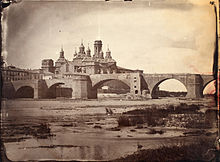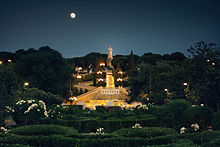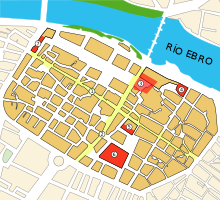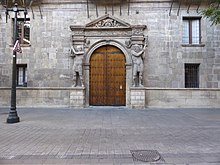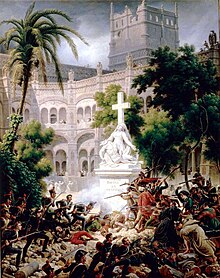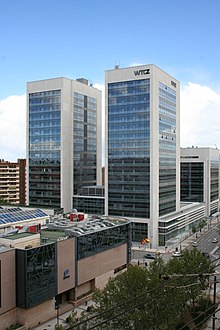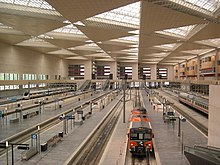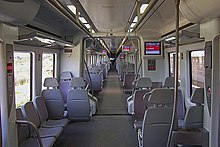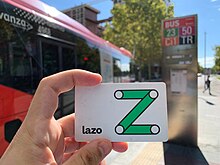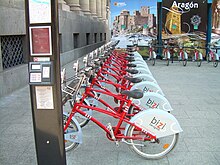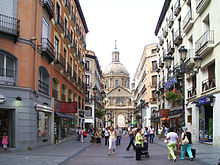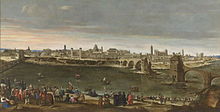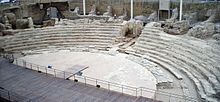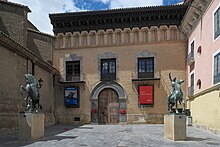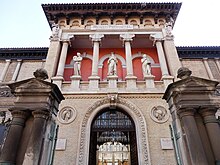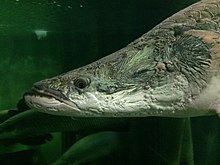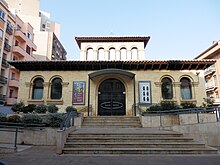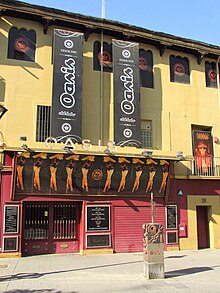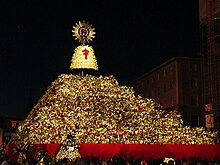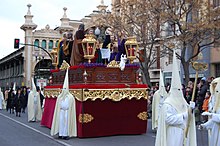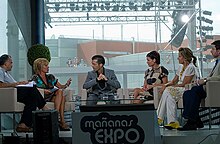Saragossa
Zaragoza is a city and a municipality in Spain, capital of the homonymous province and of the autonomous community of Aragon. Belonging to the Central Region, it has a special legal regime as the capital of Aragon. With a population of 681,877 inhabitants (INE 2020) it is the fifth most populous city in the country, after Madrid, Barcelona, Valencia and Seville.
It is located on the banks of the Ebro, Huerva and Gállego rivers and the Imperial Canal of Aragon, in the center of a wide valley. Its privileged geographical situation makes it an important logistic and communications hub; It is located about 300 km from Madrid, Barcelona, Valencia, Bilbao and Toulouse. Part of its municipal area is occupied by the managed nature reserve of Sotos y Galachos del Ebro.
The city holds the titles of Very Noble, Very Loyal, Very Heroic, Very Beneficent, Always Heroic and Immortal, granted mostly after its resistance against the Napoleonic army in the Sieges of Zaragoza during the War of Independence. All these titles are reflected in his shield, through the initials of each one of them. It celebrates its main festival in honor of the Virgen del Pilar on October 12. The patron saint of the city is San Valero (January 29). Between June 14 and September 14, 2008, the bicentennial year of the Zaragoza Sites and the centenary of the 1908 Spanish-French Exposition, Zaragoza hosted the international exhibition Expo Zaragoza 2008 dedicated to water and sustainable development. In addition, the city of Zaragoza was the headquarters of the United Nations Secretariat for the Water Decade 2005-2015.
Toponymy
Its current name comes from the ancient Roman place name, Caesaraugusta, which it received in honor of Emperor Caesar Augustus in 14 B.C. C. The origin of the city dates back to Salduie, which was the name of the Iberian city of Sedetan located on the site of present-day Zaragoza since the second half of the III a. C. It is documented in Iberian coins and with the name "Salduvia" in a text by Pliny the Elder. With the founding of Caesar Augusta, the Iberian city-state became an immune colony for Roman citizens. Its Roman name evolved, perhaps passing through the Arabic Saraqusta.
Physical geography
It sits in the middle of the Ebro valley, on the middle bank of the Ebro, where the Huerva and Gállego rivers flow, which also cross the city.
On the riverbank and in the urban area, the terrain is generally flat, especially in the northern part of the city located on the right bank of the mouth of the Gállego river, while the southern part has a more pronounced inclination as it moves away from the Ebro. The height of the Ebro river as it passes through Zaragoza is 199 ms. no. m., although much of the city is above 210 m a.s.l. and the southern neighborhoods such as Torrero and La Paz, are more than 250 m above sea level. The riverbank is surrounded by escarpments, cornices or gullies, giving rise to abrupt relief, sometimes with strong unevenness. In altitudinal contrast with respect to the metropolitan area, within the municipality, the Plana de Muses stands out, a southern segment of the Montes de Castejón at 730 meters above sea level, and the Planas de María above 600 m asl, a result of the hardness of its geological materials to erosion.
The materials that emerge in the city and its surroundings are fundamentally gravel, sand and clay product of the Ebro's own sedimentation during the Quaternary, which are arranged in fluvial terraces several meters thick on the units of gypsum and silt deposited during the Tertiary. These materials are considered evaporites, as they were formed by evaporation of water in extensive lagoons of an endorheic depression that delimited the Pyrenean, Iberian and Catalan coastal ranges. This endorheic area opened up to the Mediterranean by the erosion of one or several ravines, precursors of the current Ebro river.
The saline nature of the evaporites, together with low rainfall and a strong evaporation coefficient, have favored the development of a unique steppe vegetation in the area of Zaragoza, which constitutes a botanical and landscape rarity at a European level, although It is not valued in general by its inhabitants. The contrast between this landscape and the exuberant vegetation of the river groves is one of the attractions of the canoe descents that can be done upstream and downstream of the city.
The limits of the municipal term are the following:
| Northwest: Castejón de Valdejasa, Tauste, Torres de Berrellén, Sobradiel, Utebo, La Joyosa, Alagón, and Pinseque | North: Zuera, Villanueva de Gállego and San Mateo de Gállego | Northeast: Perdition |
| West: Trees, Bardallur, La Muela |  | This: Villamayor de Gállego, La Puebla de Alfindén, Pastriz, El Burgo de Ebro |
| Southwest: The Muela | South: María de Huerva, Cuarte de Huerva, Cadrete and Valmadrid | Sureste: Sources of Ebro, Mediana de Aragón |
Climate
According to the Köppen climate classification, Zaragoza has a cold semi-arid climate (BSk), typical of the Ebro depression. Winters are slightly cold, with mean minimums around 2 degrees Celsius, with night frosts being normal (23 days of frost on average per year), while the maximum temperatures are usually around 10 degrees on average, although during the months of December and January, due to thermal inversion during anticyclonic situations and the subsequent formation of mists (called boiras in Aragón), temperatures can plummet, becoming even lower than in the nearby areas located at a higher altitude than if they see the sun; In these events, the thermal amplitude is drastically reduced and even on rare occasions, in this type of event, negative maximums of up to three degrees below zero have been recorded, as in December 2001, which leads to the fog droplets deposited on some surfaces, freezing and forming rime (known as dorondón in Aragon). Summers are hot, the maximum often exceeds 30 °C (although they can be below this value, especially if the north wind blows), they even exceed 35 °C on some days and occasionally the barrier of 40 degrees; while the minimums due to the continentality of Zaragoza usually drop below 20 degrees, although sometimes this mark is exceeded in warm events. In terms of average and absolute summer maximums, Zaragoza is, together with Lleida, the warmest province capital in northern Spain.
The scarce rains are concentrated in spring, and in autumn to a lesser extent, with about 6 or 7 rainy days per month; there are summer droughts, with only 1 to 2 days of rain on average per month, although sometimes strong storms can occur in summer, sometimes even with hail due to the formation of convective clouds due to the heat, which ease the drought a bit. In winter, rainfall is also quite low, just a little more common than in summer, about 4 rainy days per month. Due to the winter drought, Zaragoza has an average of only 2.4 days of snow per year, as it is also located at a low altitude and therefore has relatively mild temperatures. It is even more difficult for snow to set, occurring approximately once every three years. The annual average precipitation is quite low, about 315 mm, mainly due to the foehn effect or adiabatic effect.
The highest temperatures since historical records exist are 44.5 °C on July 7, 2015; 43.2 °C on June 29, 2019; 42.8 °C on August 26, 2010 and 42.6 °C on July 17, 1978. The lowest are -15.2 °C, recorded both on January 1 and 18, 1918, - 14.9 °C, from December 31, 1887, -11.4 °C registered on February 5, 1963 and in the 21st century, only the -9.5 °C of December 25, 2001 can be highlighted. The most important snowfalls in recent history are February 2005 (15 centimeters of snow), February 2018 (6 centimeters of snow) and January 2021 (20 centimeters of snow). Most of the snowfall occurs on warm fronts from the southwest (or from the southeast to a lesser extent) after a previous cold irruption, in which cold air had settled in the Ebro valley, since with other wind components such as north, it hardly It precipitates due to its intensity and also makes it difficult for the cold to settle.
According to the State Meteorological Agency, the average wind speed is 19 km/h. The north wind blows frequently during winter and early spring. The north winds channel through the Ebro valley, changing its direction to the northwest and blowing intensely. This wind is known in the region as cierzo and is of the foen type, characterized by its dryness and mild temperatures, although with cold or very cold thermal sensations. It usually blows with a gusty character after the passage of cold fronts.
Another wind is the sultry that comes from the Mediterranean and is channeled by the Ebro valley blowing from the southeast. This is characterized by its humidity, leaving very warm thermal sensations in summer and favoring fog in winter. It usually blows less intensely than the north wind
Sometimes it also blows southwest/west (fagüeño) being like the foen-type north wind although sometimes contributing humidity if it is associated with Atlantic lows or storms in summer (which are generated in the mountains of the Iberian System). This wind, when it is drier, leaves the highest temperatures recorded in Zaragoza in summer in heat waves. In winter, if it blows soft without being able to displace the cold air settled in the valley, it can leave snowfalls from a warm front if it has a certain amount of humidity.
| Month | Ene. | Feb. | Mar. | Open up. | May. | Jun. | Jul. | Ago. | Sep. | Oct. | Nov. | Dec. | Annual |
|---|---|---|---|---|---|---|---|---|---|---|---|---|---|
| Temp. max. abs. (°C) | 20.6 | 22.5 | 28.3 | 32.4 | 36.5 | 43.2 | 44.5 | 42.8 | 39.2 | 32.0 | 28.4 | 22.0 | 44.5 |
| Average temperature (°C) | 10.5 | 13.1 | 17.3 | 19.6 | 24.1 | 29.3 | 32.4 | 31.7 | 27.1 | 21.4 | 14.8 | 10.8 | 21 |
| Average temperature (°C) | 6.6 | 8.2 | 11.6 | 13.8 | 18.0 | 22.6 | 25.3 | 25.0 | 21.2 | 16.2 | 10.6 | 7.0 | 15.5 |
| Temp. medium (°C) | 2.7 | 3.3 | 5.8 | 7.9 | 11.8 | 15.8 | 18.3 | 18.3 | 15.2 | 11.0 | 6.3 | 3.2 | 10.0 |
| Temp. min. abs. (°C) | -10.4 | -11.4 | -6.3 | -2.4 | 0.5 | 1.6 | 8.0 | 8.4 | 4.8 | 0.6 | -5.6 | -9.5 | -11.4 |
| Total precipitation (mm) | 21.0 | 21.5 | 19.1 | 39.3 | 43.7 | 26.4 | 17.3 | 16.6 | 29.5 | 36.4 | 29.8 | 21.4 | 322.0 |
| Precipitation days (≥ 1 mm) | 4.0 | 3.9 | 3.7 | 5.7 | 6.4 | 4.0 | 2.6 | 2.3 | 3.2 | 5.4 | 5.1 | 4.8 | 51.1 |
| Days of snow (≥) | 0.7 | 0.4 | 0.2 | 0.0 | 0.0 | 0.0 | 0.0 | 0.0 | 0.0 | 0.0 | 0.1 | 0.5 | 2.4 |
| Hours of sun | 131 | 165 | 217 | 226 | 275 | 307 | 348 | 315 | 243 | 195 | 148 | 124 | 2694 |
| Relative humidity (%) | 75 | 67 | 59 | 57 | 54 | 49 | 47 | 51 | 57 | 67 | 73 | 76 | 61 |
| Source: State Meteorology Agency | |||||||||||||
Parks and urban trees
Before 2008, Zaragoza had eleven large urban parks measuring more than 10 hectares, among which the following can be mentioned:
- Parque Grande José Antonio Labordeta
- Uncle Jorge Park
- Parque del Oeste de Zaragoza
- Parque Cabezo Buena Vista
- Montecanal Park
Due to the celebration of EXPO 2008, the green areas of the city increased significantly. In particular, part of the Ranillas meander was reconditioned to create the Metropolitan Water Park and a plan was drawn up for the recovery of the banks of the Ebro, Huerva and Gállego.
Among the 204 species of trees existing in the streets of Zaragoza in 2007, the most widespread are: the plane tree, the Aleppo pine, the privet, the red plum, the ailanthus, the locust, the poplar and the catalpa.
Natural environments
The natural environment of Zaragoza has as its fundamental axis its rivers, the Ebro, the Gállego and the Huerva, where there are different ecosystems such as various riverside forests or coppices. In this context, the galachos stand out, which are abandoned meanders of the Ebro river that conserve part of the water and form unique natural spaces: The galacho de La Alfranca and the galacho de La Cartuja form, together with the galacho of El Burgo de Ebro, the Nature Reserve Directed from Sotos and Galachos del Ebro. Another protected area is the Galacho de Juslibol. We can also highlight the wetlands of the Ojo del Cura pond, the Ojo del Fraile pond, the Consejera pond (all three in Casetas) and the Larralde pond (in Garrapinillos), although the latter was originally an artificial pond for irrigation. The Green Belt of Zaragoza is a natural itinerary of about 60 km in length that connects various natural spaces, parks and urban walks. It is divided into the Northern Green Ring, which has a large part of the route along the Ebro and Gállego rivers, and the Southern Green Ring, whose route runs largely along the corridor that is along the Imperial Channel of Aragon and also next to the Ebro. Another natural area is Vedado de Peñaflor.
History
Prehistory and antiquity
The city of Zaragoza has more than two thousand years of history. The oldest documented population dates from the VII century BCE. C., in the remains of some settlements from the end of the Bronze Age. The first reports of an urban settlement date from the second half of the III century BC. C. and they tell us about an Iberian city called Salduie that is identified with the name of "Salduvia" in a text by Pliny the Elder.
The Ascoli bronze, dated 89 B.C. C., rewards the Salduie horsemen for their bravery on the battlefield.
Another bronze, also written in Latin and dated to the Ides of May in the year 87 BC, initially known as Tabula Contrebiensis, and also as Botorrita-2, because it was found in Botorrita, alludes to to the construction of a ditch by the Salduvienses, a ditch whose layout would not differ much from the layout of the Acequia de la Almozara, still in service.
The Roman city of Caesaraugusta was an immune colony refounded on the Iberian city by Octavio Augusto with veterans of the Cantabrian wars between 25 and 12 B.C. C., most likely 14 B.C. C. At that time it had a rectangular floor plan and an area of 47 hectares, coinciding with the urban layout of the current old town, and its perimeter was delimited by Calle del Coso to the south and east, Avenida de César Augusto to the west and the Ebro river to the north. Shortly after, it became the most important urban center in the middle Ebro valley. The city did not decline during the late Western Roman Empire.
Middle Ages
In 452 it was conquered by the Suevi and in 466 by the Visigoths, who incorporated it into the kingdom of Tolosa. In 541 it was besieged by the Franks, although the city did not fall into their power. In 542, the outbreak of plague known as Justinian's plague appeared from Africa and hit the European Mediterranean coast until the middle of the VIII century span>.
In the VII century its episcopal see experienced a period of splendor with the figures of the bishops Braulio de Zaragoza and Tajón. In 714 it was occupied by the Saracen Musa ibn Nusair and became an important Muslim center called "Medina al-Baida Saraqusta" (Zaragoza la Blanca), which Charlemagne unsuccessfully tried to occupy in 788.
In the IX century, the Banu Qasi, a noble family of Visigothic origin converted to Islam shortly after the invasion, the They designated the capital of their extensive domains shortly after 852 with Musa ibn Musa, known in Christian tradition as the "Moro Muza." Later, the emir Mohamed I of Córdoba bought it from him in 884 for 15,000 gold dinars. In 890, the Tuyibíes, Yemenis from the areas of Calatayud and Daroca, obtained hegemony, and Muhammad Alanqar became the governor of Zaragoza.
Capital on the upper border with the Christian kingdoms under the Umayyad Caliphate, it enjoyed some autonomy from Córdoba. The Muslim Zaragoza of the X century welcomed communities of other Book religions in the Jewish quarter and the Mozarabic quarter. After the disintegration of the Andalusian caliphate, it became the capital of an important kingdom, the Taifa of Saraqusta, in 1018, with the reign of the Tujib Mundir I.
The period of splendor of the Islamic city occurred in the XI century, especially with the reign of Al-Muqtadir (1046-1081), already belonging to the Banu Hud dynasty, who expanded his kingdom with the annexation of the taifa of Tortosa and the taifa of Denia and subjected the taifa of Valencia to vassalage. He built a splendid fortified recreational palace: the Aljafería, whose works began in 1065. The Hudi dynasty managed to maintain its independence against the Almoravid Empire and the pressure of a young kingdom of Aragon, until in 1110 the city had to be handed over to power. marabout, who put the former mayor of Valencia Muhammad ibn al-Hajj in charge of the governorship of the city. In 1115 he was replaced by Ibn Tifilwit, who appointed the great philosopher Avempace as vizier.
With the help of his Occitan allies and Frankish Crusaders, and his army of Aragonese, Alfonso I the Battler was able to reconquer Zaragoza in 1118, which would soon become the capital of the Kingdom of Aragon, and was the seat where he crowned the kings of the Crown of Aragon. The Muslim population had to move outside the city walls, where he founded the new Moorish neighborhood, while the urban nucleus was repopulated by Franks and given as a fief to Gastón IV de Bearne.
Since the end of the XIII century it was the center of the Aragonese Union (association of nobles to limit royal power and maintain its privileges), until it was defeated by Pedro the Ceremonious in 1384. The dynastic union of the Crown of Castile and that of Aragon transformed it into one more city of the Habsburg monarchy. The establishment of the Inquisition was the cause of major riots and the assassination of the inquisitor Pedro Arbués in 1485. In the XV century, the to the city the suburbs of farmers from San Pablo and fishermen from Las Tenerías. During the reign of Fernando el Católico, the university was founded and the Lonja was built. The expulsion of the Jews in 1492 and the Moors in 1609 caused a certain stagnation in its growth, but despite this, it did not stop being an important city (with 25,000 inhabitants in 1548).
Modern Age
It was the scene of riots due to the imprisonment of Antonio Pérez, secretary of Felipe II, who, processed by order of the king, took refuge in the protection of the Aragonese Fueros in 1591. The riots ended with the execution of Justice Juan de Lanuza and the introduction of some restrictions on their privileges. During the War of Succession, the city, in defense of the freedoms and sovereignty of Aragon, its institutions and Aragonese Law, declared itself a supporter of Archduke Carlos of Austria. When it was conquered by the Bourbon troops, it lost the autonomy it had enjoyed up to that moment (1707), and which it could only recover briefly in 1710, when its privileges were repealed by the Nueva Planta Decrees, with which the city ceased to be to be the headquarters of important institutions of the Kingdom of Aragon.
During the 18th century the population rose from 30,000 in 1725 to 43,000 in 1787. In 1760 there was a parallel riot of Esquilache, and in 1776 the Economic Society of Friends of the Country was founded.
Contemporary Age
During the Spanish War of Independence (1808-1814) Zaragoza resisted the clashes with the French troops. In the war against Napoleon it became famous throughout Europe for its sieges, being a symbol of resistance to Napoleon. In the first siege (June-August 1808), General Verdier had to give up taking it. In the second siege (late December 1808-January 21, 1809) it capitulated after a series of very violent combats, where the population heroically collaborated with the troops of the defenders, under the orders of José de Palafox, who locked themselves up with 30,000 men. Moncey and later Lannes led the second siege. It is estimated that 8,000 Frenchmen and 40,000 defenders died, as an epidemic of typhus spread within the city.
During the Carlist Wars, the Carlist general Juan Cabañero tried to occupy the city at dawn on March 5, 1838, but was rejected by the garrison. On January 2, 1854, there was a frustrated attempt at a pronouncement.
The cholera of 1885 caused many victims. However, in the year 1900 the city had about 100,000 inhabitants. Also in the 19th century the first important transformations that have shaped the current city took place: the location of the railway station (Estación del Norte), which generated a residential and industrial nucleus, and the gradual construction of the Paseo de la Independencia (started in 1815), with its porches, which created an axis that went from the Coso to the Huerta de Santa Engracia and articulated the growth towards what would constitute the widening of the early XX century, with Gran Vía and Paseo de Sagasta as the main streets. At the end of the XIX century, it became the focus of strong rural immigration attracted by the recent process of industrialization of the city.
After 1898, the cane sugar supplied by the lost colonies began to be replaced by beet derivatives, which gave rise to the rise of the sugar industries in Zaragoza and the appearance of a bourgeoisie that encouraged the regenerationist movements of the National League of Producers (1899) and the National Union (1900) of Joaquín Costa and Basilio Paraíso. The accumulation of capital caused by the sharp increase in profits gave rise to the creation of several regional financial entities, such as the Banco Zaragozano or the Banco de Aragón. Rural immigration took place, the appearance of a proletariat and the urban growth of the city. The economic expansion brought with it periods of famine and inflation and caused the consequent workers' demands. These were neglected by an intransigent local bourgeoisie protected by the violent repression of the forces of order. All this led to the failure of labor reformism and the sustained growth of affiliation to the National Confederation of Labor. During the first decades of the XX century, Zaragoza was the second CNT city in Spain after Barcelona.
At the beginning of the Spanish Civil War, on July 19, 1936, the rebels, commanded by General Miguel Cabanellas, easily took control of the city. In 1937, the Republicans launched the Zaragoza offensive to try to regain control of the city, without success.
During the dictatorship, the General Military Academy was reopened, which had been closed in 1931 and converted into a Francoist concentration camp during the war, and the Ebro Hydrographic Confederation was installed. After various urban plans that completed the layout of the XIX century, there was an enormous growth in the urban center in the last thirty years of the century with the overcoming of the natural barrier that constitutes the Ebro, and that has led to the construction of populous new neighborhoods. From the second half of the XIX century to the present day, Zaragoza has continued to thrive, currently being the fifth city in Spain in demographic terms.
Demographics
Since the founding of Caesaraugusta as a Roman colony, its limits have welcomed a population of around 20,000 inhabitants. During the Visigothic period its population slightly decreased although it maintained its strength as a key city in the north of the peninsula.
| Graphic of demographic evolution of Zaragoza between 1842 and 2019 |
 |
Population of law according to population censuses of the INE.Population according to the 2017 municipal register. |
The arrival of the Muslims on the peninsula and the creation of the brand and subsequent Taifa of Zaragoza made Saraqusta one of the most important capitals of the first Taifa kingdoms. In its time of maximum splendor (around 1080) it dominated, as the center of a fundamentally urban Islamic kingdom, a large part of the peninsular Levant, including the coast of Tortosa and Denia. At that time, Zaragoza could have had 25,000 inhabitants, and even the most optimistic calculations would bring the city to around 50,000.
| Population pyramid 2010National Institute of Statistics of Spain | ||||
| % | Men | Age | Women | % |
| 0.89 | 85+ | 1.91 | ||
| 1.24 | 80-84 | 1.93 | ||
| 1.83 | 75-79 | 2.42 | ||
| 1.77 | 70-74 | 2,15 | ||
| 2.25 | 65-69 | 2.44 | ||
| 2.65 | 60-64 | 2.86 | ||
| 2.82 | 55-59 | 2.93 | ||
| 3,37 | 50-54 | 3,36 | ||
| 3,83 | 45-49 | 3.67 | ||
| 4,13 | 40-44 | 3,83 | ||
| 4.48 | 35-39 | 4.03 | ||
| 4.52 | 30-34 | 4,088 | ||
| 3.6 | 25-29 | 3,34 | ||
| 2.8 | 20-24 | 2.69 | ||
| 2.26 | 15-19 | 2,17 | ||
| 2.19 | 10-14 | 2.04 | ||
| 2.36 | 5-9 | 2.23 | ||
| 2.55 | 0-4 | 2.39 | ||
It is difficult to establish a precise estimate of the variations experienced during the Christian medieval period. After the reconquest of Alfonso I of Aragon in 1118, the Islamic population was forced to live in the suburbs, leaving the old medina for the new settlers. Part of the population, especially those belonging to the highest social strata, marched towards al-Andalus. It is known that the XII century was a period of crisis, which, together with the aforementioned emigration, could have caused the population to drop significantly, despite the legal privileges that the Aragonese kings strove to promulgate to stimulate their settlement in the capital of the kingdom. In any case, at the end of the XV century, Zaragoza recovered the population it had at its peak as the capital of the Taifal kingdom with 20,000 inhabitants approximately.
The first half of the XVI century contemplates a citizen Renaissance, with the construction of La Lonja and the presence of a landscape an urban area dominated by numerous Mudejar-style towers, which earned Zaragoza the nickname of "the one with a hundred towers" or "Spanish Florence". Thus, in 1548 the city had 25,000 inhabitants. There must have been no significant changes in demography during the XVII century, a period of demographic crisis in general in Spain and in particular in Aragon, where plagues, famines and the economic crisis were joined by the final expulsion of the Moors in 1609.
In contrast, during the 18th century (the century in which the first census estimates of demography begin) the population experienced an important boom, and evolved from about 30,000 inhabitants in 1725 to 43,000 in 1787.
| Nucles | Inhabitants (2017) | Male | Women |
|---|---|---|---|
| Alfocea | 169 | 91 | 78 |
| The Low Cartridge | 2011 | 995 | 1016 |
| Cases | 6560 | 3352 | 3208 |
| Garrapinillos | 5109 | 2613 | 2496 |
| Juslibol | 1535 | 907 | 628 |
| Mountain | 3128 | 1577 | 1551 |
| Monzalbarba | 1850 | 936 | 914 |
| Move. | 2634 | 1345 | 1289 |
| Peñaflor | 1200 | 602 | 598 |
| San Gregorio | 582 | 291 | 291 |
| San Juan de Mozarrifar | 2513 | 1263 | 1250 |
| Torrecilla de Valmadrid | 25 | 14 | 11 |
| Venta del Olivar | 914 | 390 | 524 |
| Villarrapa | 167. | 83 | 84 |
| Zaragoza | 636541 | 303960 | 332581 |
But the War of Independence and the two sieges it suffered by Napoleonic troops devastated Zaragoza which, from the 55,000 citizens who inhabited it in 1808, fell to 12,000 survivors. Despite all this, the dynamism of the capital of the middle Ebro valley allowed it to recover and by 1850 it already had 60,000 inhabitants; this demographic rise continued very remarkably in the second half of the century XIX in which it was favored by industrial activity (mainly beet sugar factories and the food industry) and commercial activity that led its population to exceed 100,000 inhabitants at the beginning of the century XX.
Between the 1887 census and the previous one, the term of the municipality grew because it incorporated Alfocea, Casetas, Juslibol and Monzalbarba. Between the 1900 census and the previous one it incorporates Peñaflor, between the 1920 census and the previous one it incorporates Villamayor.
At the arrival of the Second Republic, the city had close to 200,000 inhabitants and in 1960 it reached 300,000. But the true demographic boom occurred between 1960 and 1980, a twenty-year interval in which Zaragoza almost doubled its population, exceeding half a million souls in the mid-eighties and 600,000 at the end. In the first decade of the XXI century It continues to grow, partly due to its status as a magnet for the Aragonese population, which emigrates from the rural areas of the region, and according to the municipal register in 2018 it had 697,895 inhabitants.
In the 1960 census, Torrecilla de Valmadrid was incorporated into the city limits. Between the 2011 census and the previous one, the municipal term decreased when Villamayor de Gállego was segregated in 2006. The census that appears as 2011 corresponds to December 30, 2010.
Immigration
In 2013, 107,864 foreigners lived in Zaragoza, representing 15% of the total. From 2004 to 2013, this figure went from 43,355 to 107,864, that is, it increased by almost 150%. The neighborhoods with the largest foreign population were Delicias (25,428 inhabitants, 23% of the total for the district) and the Historic District (11,881, 25%).
Administration and politics
Municipal government
| Political party | 2019 | 2015 | 2011 | 2007 | 2003 | 1999 | 1995 | 1991 | 1987 | 1983 | 1979 |
|---|---|---|---|---|---|---|---|---|---|---|---|
| Councillors | Councillors | Councillors | Councillors | Councillors | Councillors | Councillors | Councillors | Councillors | Councillors | Councillors | |
| Spanish Socialist Workers Party (PSOE) | 10 | 6 | 10 | 13 | 12 | 10 | 6 | 15 | 13 | 18 | 11 |
| Popular Party (PP) | 8 | 10 | 15 | 15 | 11 | 15 | 15 | 7 | |||
| Citizens (Cs) | 6 | 4 | |||||||||
| Zaragoza in Common (ZeC) | 3 | 9 | |||||||||
| Vox | 2 | ||||||||||
| We can. | 2 | ||||||||||
| Chunta Aragonesista (CHA) | - | 2 | 3 | 3 | 6 | 4 | 2 | - | - | ||
| United Left (IU) | 3 | 1 | - | - | 4 | 3 | 2 | ||||
| Aragonese Party (PAR) | - | - | - | 2 | 2 | 2 | 4 | 6 | 8 | 4 | 7 |
| Democratic and Social Centre (CDS) | - | - | 3 | - | |||||||
| Popular Alliance (AP) | 5 | 8 | |||||||||
| Communist Party of Spain (PCE) | 1 | 4 | |||||||||
| Union de Centro Democrático (UCD) | 7 | ||||||||||
| Work Party of Spain (PTA) | - | - | 2 |

Following the 2019 elections, Jorge Azcón, from the Popular Party, was elected mayor, who also had the support of the Ciudadanos and Vox councillors.
Administrative division
Zaragoza is divided into 16 districts, of which 15 are urban districts, corresponding to the main population nucleus; the sixteenth, the Rural District, comprises fourteen rural neighborhoods:
| # | District | Barrios | # | District | Barrios |
|---|---|---|---|---|---|
| District 1 | Centre | District 9 | Torrero | Torrero, La Paz, Venice and San Antonio | |
| District 2 | History | El Gancho/San Pablo, La Magdalena, San Miguel, Tenerías y San Agustín | District 10 | Actur-Rey Fernando | ACTUR and Parque Goya |
| District 3 | Delights | La Bombarda, La Bozada, Delicias, Monsalud, Parque Roma and Ciudad Jardin | District 11 | The Rabal | Arrabal, Cogullada, Jesus, La Jota, Picarral, Vadorrey and Zalfonada |
| District 4 | University | Romereda | District 12 | Casablanca | |
| District 5 | San José | Miraflores and San José | District 13 | Santa Isabel | |
| District 6 | Sources | District 14 | Miralbueno | ||
| District 7 | The Almozara | District 15 | South | Rosales del Canal, Montecanal, Valdespartera and Arcosur | |
| District 8 | Oliver-Valdefierro | Valdefierro and Oliver | District 16 | Rural district | It comprises the rural districts of Alfocea, Casetas, Garrapinillos, Juslibol, La Cartuja Baja, Montañana, Monzalbarba, Movera, Peñaflor, San Gregorio, San Juan de Mozarrifar, Torrecilla de Valmadrid, Venta del Olivar, and Villarrapa |
Evolution of outstanding debt
| The evolution of the city council's living debt between 2008 and 2021 |
 |
Living city council debt in thousands of euros according to data from the Ministry of Finance and Public Service. |
The concept of outstanding debt includes only debts with savings banks and banks related to financial credits, fixed-income securities and loans or credits transferred to third parties, excluding, therefore, commercial debt.
The outstanding municipal debt per inhabitant in 2015 amounted to €1,608.65.
Economy
Zaragoza is the fifth city in Spain according to its Economic Activity Index. The strategic sectors of the Zaragoza economy are the automotive industry, logistics and transport, renewable energy, business services, agribusiness and the sightseeing. In the city's economy, the Opel factory (PSA Group) in Figueruelas occupies a prominent place, a town in the metropolitan area, around which a network of auxiliary motor industries has developed.
In the industrial field, there are also household appliance companies such as BSH (Bosch, Siemens, Balay), food and beverage companies such as Supermercados Sabeco, Chocolates Lacasa, Rivasam Intercontinental S.A and La Zaragozana, automobiles such as Opel España S.A, products textiles such as Adidas España S.A, paper and cardboard such as Industrias Celulosa Aragonesa S.A and Torraspapel S.A, mattresses such as Pikolin, trailers such as LeciTrailer and Schmitz Cargobull or lifting machinery such as Schindler.
The transport of goods from the Zaragoza airport stands out, which in 2017 loaded 117,000,000 kg, making it the third best Spanish airport (in terms of goods) just behind Madrid and disputing second place with Barcelona.
Projects such as the Zaragoza Logistics Platform (PLAZA), which with 12,500,000 m² is the largest in southern Europe, have boosted the logistics sector in recent years. In addition, the opening of Puerto Venecia, the largest shopping center in Europe, has created nearly 4,000 jobs, being an important center of national and international tourist attention.
In addition to this type of large commercial initiatives are others that stimulate the establishment of offices in the city, such as the World Trade Center Zaragoza building or the space for the 2008 International Exhibition, converted into a business complex and the Justice City.
Companies in the area of influence of Zaragoza by turnover:
| Rank | Social reason | Billing 2016 | Employees | Sector |
|---|---|---|---|---|
| 1 | Opel España S.A | 4 297 414 000 € | 5365 | Manufacture of motor vehicles |
| 2 | BSH Appliances Spain S.A | 1 576 671 000 € | 4322 | Manufacture of appliances |
| 3 | Alliance Healthcare S.A | 1 283 668 000€ | 900 | Pharmaceutical products |
| 4 | Supermarkets Sabco S.A | 932 862 560 € | 4306 | Child trade |
| 5 | Aragonese Celulous Industries S.A (SAICA) | 928 319 348 € | 640 | Paper and cardboard manufacturing |
| 6 | Ibérica SL | 712 528 000 € | 309 | Wholesale commerce of computers and software |
| 7 | Rivasam Intercontinental S.A | 539 726 000 € | 54 | Production of meat and flyer products |
| 8 | Fujikura Automotive Europe S.A | 419 994 552 € | 198 | Manufacture of other material and electrical equipment |
| 9 | Adidas España S.A | 380 059 443 € | 1283 | Clothing and footwear |
| 10 | Schindler S.A | 321 608 000 € | 2344 | Manufacture of lifting and handling machinery |
Services
Health
The Aragonese Health Service is the body that integrates all public health centers in Aragon. It is structured into eight health sectors and, within this structure, Zaragoza contains three of them, called Zaragoza I, Zaragoza II and Zaragoza III. Each of these sectors has its corresponding primary care centers, specialty centers, hospitals, and mental health centers.
The list of hospitals, both in the public and private sectors, existing in Zaragoza is as follows:
| Hospital centre | Type | No. of beds |
|---|---|---|
| Hospital Universitario Miguel Servet | Public | 1345 |
| Hospital Clínico Universitario Lozano Blesa | Public | 808 |
| Hospital Neuropsychiatric Nuestra Señora del Carmen | Public | 287 |
| Hospital Royo Villanova | Public | 260 |
| Centro de Rehabilitación Psicosocial Nuestra Señora del Pilar | Public | 172 |
| Hospital General de la Defensa in Zaragoza | Public | 200 |
| Hospital San Juan de Dios | Public | 188 |
| Hospital Provincial Nuestra Señora de Gracia | Public | 151 |
| Hospital de la Mutua de Accidents de Zaragoza | Private | 119 |
| Clínica Quirón | Private | 104 |
| Clínica Montpellier | Private | 92 |
| Clínica Montecanal | Private | 56 |
| Comprehensive Rehabilitation of Mental Health Project in Aragon | Private | 50 |
| Rehabilitative Unit of Media Estancia Professor Rey Ardid | Private | 39 |
| Clínica Nuestra Señora del Pilar | Private | 34 |
| Source: Ministry of Health, Social Services and Equality. | ||
Transportation
Airport
The official name is Zaragoza Airport (IATA code: ZAZ). Its inauguration dates back to September 1947, when it still had the name of General Sanjurjo Airport and is located in the Garrapinillos neighborhood, 10 kilometers from the city center. The airport is connected by the bus line 510 with a frequency of 30 minutes. The transfer by taxi has an approximate cost of 20 euros. It has car rental services (Atesa, Europcar, Hertz, Sixt). In addition to ATMs, cafeterias, restaurants, travel stores, shopping, it has WIFI internet service. In 2011, it transported 751,097 passengers (according to AENA). In March 2008, on the occasion of the International Water Exhibition, a new terminal (T1) was opened. The modern building has a capacity for one million passengers per year, although it is expandable up to a million and a half. Currently, several airlines operate at the airport (Ryanair, Air Europa, Air Nostrum, Volotea, Vueling, Wizz Air, Air Horizont or Binter Canarias among others) and there are permanent connections with various European destinations such as: London, Paris, Brussels, Milan, Cluj-Napoca or Bucharest and other nationals: Mallorca, Tenerife and Lanzarote, to which are added many other summer connections (Gran Canaria, Fuerteventura, Ibiza or Menorca).
Regarding freight transport, Zaragoza airport is experiencing strong growth that has placed it as the third in Spain since 2009, a consolidated position in 2011 with 48,647 tons of cargo, 14.3% more than in 2010. In 2016 the airport put into service the new instrument landing system, ILS (Instrumental Landing System) category II/III, which allows aircraft certified for this type of operation to operate in conditions of low visibility, practically zero. This category, the maximum existing, allows aircraft to land with a runway visual range of less than 200 meters and a cloud ceiling between 0 and 30 meters.
Railway
On October 11, 2003, the Madrid-Zaragoza-Lérida high-speed line (AVE) was inaugurated, ensuring the connection between Zaragoza and Madrid in 90 minutes. The extension of the high-speed line to Barcelona was inaugurated on February 20, 2008. Since May 2007, the new Zaragoza-Delicias Intermodal Station, located in the La Almozara district, also houses the central bus station of the town.
The city has three other railway stations: El Portillo station, Goya station, and Miraflores station. All of them serve the Zaragoza commuter line and several Renfe medium-distance lines.
Between 2008 and 2010, the dry port and the railway intermodal logistics area of PLAZA (Zaragoza Logistics Platform) began to operate, totaling 2.6 million square meters between both surfaces. In addition, the city also has the dry port of "MercaZaragoza" and the railway docks of various companies such as SAICA or Montañanesa.
Road
Except for Soria, Zaragoza is connected by highways and highways with all the capitals of the neighboring provinces. The city is located 74 kilometers from Huesca, 152 kilometers from Lérida, 160 kilometers from Soria, 170 kilometers from Logroño, 173 kilometers from Teruel, 178 kilometers from Pamplona, 236 kilometers from Tarragona and 253 kilometers from Guadalajara..
Zaragoza has two ring roads:
- Z-30, urban round limited to 50 km/h that relieves traffic in the city center
- Z-40, a motorway that completely surrounds the city and allows the articulation of the metropolitan area and the distribution of national, regional and urban transits.
The other highways that cross the territory are:
- A-2, a state motorway linking Madrid with Barcelona through Zaragoza. The section between Zaragoza and Fraga has not been unfolded and maintains the name N-2, as an alternative route to the AP-2.
- AP-2, state toll highway linking Zaragoza with Vendrell, province of Tarragona.
- AP-68, state toll road linking Bilbao with Zaragoza.
- A-23, a state motorway linking Sagunto, province of Valencia with Huesca through Teruel and Zaragoza. It is expected to reach the border with France.
- N-232, road linking Vinaroz, province of Castellón with Santander through Zaragoza. Communicate the city with towns like Tudela and Alcañiz. It has several sections dedoblated under the name A-68.
- N-330, is the national road with a trace similar to that of the A-23 motorway.
- N-125, national road that allows access to Zaragoza airport.
- A-129, autonomic road linking Zaragoza with Sariñena.
- A-123, autonomic road linking Zaragoza with Zuera.
- A-120, autonomic road that allows access to PLAZA and airport from the Arco Sur neighborhood.
- Incipient planning is the Z-50, whose first phase would surround the city in the south from La Muela, in the A-2, until it entered the Aragonese toll road ARA-A1, to which it would absorb. The Z-50 is presented as an autonomic toll free motorway project although supported and co-financed by the State given its impact on the decongestion of the state roads in the strategic node viario of Zaragoza.
Urban and metropolitan transport
- Nearby trains
Since June 11, 2008, Zaragoza has had its first Cercanías line: Casetas-Utebo-Delicias-Portillo-Goya-Miraflores.
On April 4, 2012, the Goya station, located between El Portillo and Miraflores, was opened to the public. This stop is called to be the cornerstone of the Cercanías system given its centrality and its correspondence with Line 1 of the tram. In the future, the C-1 should be extended to the west and east, reaching Alagón and El Burgo de Ebro, respectively.
The second commuter line, still in the pipeline, will have a North-South layout, perpendicular to the C-1 on a metropolitan scale, although sharing tracks in the urban area of Zaragoza. In the long term, it is expected to reach from Zuera to María de Huerva, although, in a first phase, it could cover the El Portillo-Intermodal Station-Logistics Platform (PLAZA) route.
- Metropolitan buses
The Zaragoza peri-urban bus service serves around thirty municipalities located within a 30 km radius of Zaragoza. There are six main corridors:
- North: San Juan de Mozarrifar, Urbanization El Zorongo, Villanueva de Gállego, Las Lomas del Gállego, San Mateo de Gállego and Zuera.
- Northeast: (Villamayor de Gállego, Movera, El Lugarico de Cerdán, Pastriz, La Puebla de Alfindén, Alfajarín, Nuez de Ebro, Villafranca de Ebro, Osera de Ebro, Aguilar de Ebro and Pina de Ebro).
- Southeast: (El Burgo de Ebro, Fuentes de Ebro y Pina de Ebro)
- South: (Huerva, Urbanization Santa Fe, Cadrete, María de Huerva and Botorrita)
- Southwest: (PLA-ZA, Zaragoza Airport, La Muela and Alto de la Muela Urbanization)
- Northwest: (Urbanización Torres de San Lamberto, Venta del Olivar, Monzalbarba, Alfocea, Utebo, Casetas, Garrapinillos, Urbanización Torre Pinar, Urbanización Torre Medina, Sobradiel, La Joyosa, Torres de Berrellén, Villarrapa and Pinseque).
The service is financed by the various town halls, the DPZ, the DGA and by the users themselves. It is served by several transport companies, although all of them are part of the Zaragoza Area Transport Consortium. The usual corporate color is red with wavy orange stripes and the Interbús card is available on all consortium lines, which is compatible with the Urban Buses of Zaragoza and with the tram. In addition, there are five transport interchanges in the city of Zaragoza to which the metropolitan buses arrive.
- Tram
The first phase of tramway line 1 was inaugurated on April 19, 2011, and was fully inaugurated on March 26, 2013. Line 1, with a North-Center-Southwest layout, measures 12.8 km in length, interconnecting the neighborhoods of Valdespartera, Casablanca, Romareda, Universidad, Centro, Casco Histórico, Actur, Juslibol and Parque Goya as well as connecting the two main campuses of the University of Zaragoza. The Emperador Carlos V, Fernando el Católico-Goya and León Felipe/Rosalía de Castro stops serve as an interchange with the CTAZ metropolitan buses or with the Cercanías de Zaragoza The concessionaire company for the Tram service is TRAZA. In 2016, it provided service to 27.9 million users.
The creation of a second line with a West-centre-East layout has been discussed. Line 2 would connect the neighborhoods of Valdefierro, Oliver, Delicias, La Bombarda, Centro and through two branches the neighborhoods of Las Fuentes and San José. In addition, this line would allow connecting with the Zaragoza-Delicias Station by tram.
The creation of a third line has also been considered, which would link Torrero and La Jota passing through the urban center. The extension of line 1 to the southwest has also been considered, connecting in this way with the new neighborhood of Arcosur.
- Urban buses
Urban transport in Zaragoza is based primarily on bus transport provided by the concessionary company AUZSA (Autobuses Urbanos de Zaragoza S.A), formerly known as TUZSA (Transportes Urbanos de Zaragoza S.A), which has a fleet of about 350 vehicles, a staff of close to 750 employees, 44 lines of which 33 are urban lines, 2 circular and 2 shuttles (of which one is a free service) and 7 night buses that operate only on weekends and run close to 115 million annual trips. This company also operates the Tourist Bus, one of the first emerging services in the city of Zaragoza.
- Public transport statistics
The average time that people spend on public transport in Zaragoza, for example to and from work, on a weekday is 48 min, while 9% of people spend more than 2 hours all the days. The average time that people wait at a stop or station is 11 minutes, while 12% of people wait more than 20 minutes each day. The average distance people typically travel in a single trip is 4.2 km, while 5% travel more than 12 km in one direction.
Bicycle
In May 2008, shortly before the opening of the International Exhibition, a public rental bicycle system called Bizi Zaragoza was implemented in the city. At the end of the first phase, the system made available to citizens 340 bicycles distributed in 29 stations distributed, mainly, along the banks of the Ebro, the city center and the access roads to the Exhibition site. In May 2009 the number of stations increased to 49 and in October of that same year, several months ahead of schedule, the system began to have 1,000 bicycles at 100 access points, reaching the figure of 29,034 subscribers in April 2010. After the latest expansion, with 130 stations and 1,300 bicycles, the number of users of Bizi Zaragoza reached a maximum of 37,500 at the end of 2013, registering 35,500 in December 2014. One of the factors that most influenced the decrease in subscribers was the execution of a judgment of the Court S Superior Justice of Aragon that forced the City Council to annul the municipal ordinance that allowed the circulation of bicycles on the sidewalks.
Other services
There is a tourist boat transport service, which runs the river route between the port of Vadorrey and the Expo area, making a mandatory stop at the Club Náutico (at the foot of the Basilica del Pilar). This service presents problems with the draft of the ships and has never been fully operational.
There are also several little tourist trains that in summer connect the town center with the peri-urban natural spaces of the Juslibol galacho and the La Alfranca galachos.
Heritage
Zaragoza is a two-thousand-year-old city through which practically all the civilizations that have dominated the Iberian Peninsula have passed and of which remains and monuments remain, despite the destructive effect that the sites suffered during the years had on the architectural heritage the war of the independence.
The three main attractions are:
- The Cathedral of Our Lady of El Pilar is the largest baroque temple in Spain. There are works of art such as the altarpiece of the main altar of Damián Forment, the sillery of the choir of the century. XVI, and the Santa Capilla, work of the architect Ventura Rodríguez of 1750. It also houses frescoes by Goya and Francisco Bayeu, among others.
- The Cathedral of the Saviour (La Seo), recently restored and mixed styles—romanic, Gothic, Mudejar and Baroque—is built on the remains of the Mosque of Muslim times and, in turn, on a Roman temple. From the exterior the cimborrium, the apse, the Mudejar wall — declared World Heritage of Humanity by Unesco within the whole of the Mudejar architecture of Aragon— and the Baroque tower. The interior contains a large number of works of art such as the Gothic altarpiece, the organ, the choir, the trascoro, the set of Renaissance and Baroque chapels or the Tapices Museum.
- The Palace of the Aljafería is an Arab building that was the palace of King Al-Muqtadir of the taifa of Saraqusta in the century XI. It was also used by some kings of Aragon as Pedro IV the Ceremony and Fernando the Catholic, among others. It was subsequently used as the headquarters of the Inquisition and today it is the Courts of Aragon, after a wide restoration, which included the reconstruction of some areas. The courtyard is surrounded by horseshoe arches intertwined with plasterwork, the mihrab, and the upper floor, with a Renaissance bill, with the large access staircase and the throne room.
See also:
- Zaragoza
- Medieval Zaragoza and Mudejar
- Renaissance Zaragoza
- Zaragoza baroque
- Neoclassical Zaragoza
- Modernist Zaragoza
- Contemporary Zaragoza
Contemporary architecture
Inside the city architecture of the late 20th and early XXI can be highlighted:
- the Auditorium of Zaragoza;
- the Intermodal Station Zaragoza-Delicias;
- the Headquarters of the Regional Confederation of Entrepreneurs of Aragon (CREA), former Aragon Pavilion of the Universal Exhibition of Seville;
- the building of the Pablo Serrano Museum;
- Cinegia gate, a commercial and residential space that closes harmoniously the zaragozano tube;
- the building of the World Trade Center Zaragoza, a business complex located in the Actur district in Zaragoza, one of the highest buildings in the city;
- Aragonia, a business, commercial, residential and leisure complex designed by Rafael Moneo;
- the Digital Water Pavilion, a construction that forms part of the project known as the Digital Milla with the participation of MIT;
- the Azud of Vadorrey, which allows navigation in the Ebro;
- the new terminal of Zaragoza Airport released in 2008;
- the building of CaixaForum Zaragoza, a cultural space with rooms for temporary exhibitions.
In addition, various infrastructures were built for the 2008 International Exposition, including the Spanish Pavilion, the Bridge Pavilion, the Water Tower, the Zaragoza Conference Center, the Aragon Pavilion, the Puente del Third Millennium and the Volunteer Catwalk.
Featured areas
Among the most emblematic and crowded streets and squares are:
- The Plaza del Pilar, in whose surroundings are the Pilar, La Seo, the Town Hall and the Lonja among other buildings.
- The Paseo Independencia, Plaza de España and Plaza de Aragón, which is considered the center of Zaragoza.
- Alfonso I street, which is directly referred to the Basilica of the Pilar.
- St. Bruno's Square. In this square are organized outdoor markets as disparate as the medieval market, the antiques market or the artisanal food market, which is organized every Sunday.
Culture
The city has the University of Zaragoza, in operation since 1583, after having been approved by Carlos V in 1542 and by the Pope in 1554. Its origins are located in the "General Study of Arts" created in 1474 on a former school. Currently, it is distributed among several campuses, two of which are in the city (San Francisco Campus and Río Ebro Campus).
The Spanish-French Exposition of 1908 was held in Zaragoza, which commemorated the first centenary of the Sites of Zaragoza and also the 2008 International Exposition, with the theme “Water and sustainable development”. Likewise, it was chosen as the headquarters of an Office of the United Nations Organization for the Water Decade 2005-2015.
Museums
See also: Annex:Museums of Zaragoza
In Zaragoza there is a varied network of museums and exhibition halls:
- The History Center presents in sequence the different historical stages of the city of Zaragoza. On the upper floor of the center is the School-Museum of Origami of Zaragoza, which exhibits works made by papiroflexia.
- There are four museums that house the remains of urban spaces of the Roman Caesaraugusta—the Roman theatre, the forum, the thermal baths and the port—and explain their evolution, use and importance in the life of the city. They are the Caesaraugusta Theatre Museum, the Caesaraugusta Forum Museum, the Caesaraugusta Public Thermal Museum and the Caesaraugusta Fluvial Port Museum.
- The Museum of Zaragoza, whose work is distributed in several buildings. The main one is the building built by Ricardo Magdalena for the 1908 Hispano-Francesa Exhibition in the Place of the Sites and is divided between a section of archaeology and another of beautiful arts. Other funds of the museum belong to the Section of Ethnology, located in the reproduction of an old house from the entrance to the José Antonio Labordeta Park, where everyday and indumentary elements of the Aragonese society of the century are exposed. XIX. Next to the latter is the house of Albarracín, where the Ceramic Section is located.
- The Alma Mater Museum (MUDIZ) is part of the Archbishopric Palace. It presents the history of the archdiocese of Zaragoza and exhibits works of art related to it.
- The Museo de Tapices de La Seo is located in the Cathedral of Salvador and boasts an exceptional collection of tapestries from the centuries. XV-XVIIIconsidered one of the best collections in Europe. There are also important works of the Cathedral Treasury.
- The Goya Museum exhibits the collection of paintings by José Camón Aznar, which spans works from the centuries XV until XX. which also includes drawings. It also features the complete collection of Goya engravings. In its basement there are some monumental remains of Roman times.
- The New Tower Museum, dedicated to the memory of the New Tower, demolished in the century XIX. It is located in the Montal House, a Renaissance palace.
- The Pilarist Museum, located in the Basilica of Pilar, exhibits works of art related to devotion to the Virgin of Pilar.
- The Museum of Fire and Firefighters, located in the former convent of Minimos de la Victoria, which exposes the evolution of the media used by the firefighters in Zaragoza throughout history.
- The Museum of La Zaragozana, located at the facilities of this old brewing factory. In it you can contemplate the whole process of brewing the beer and the historical evolution of the factory.
- The Pablo Gargallo Museum, located in a Renaissance building, exhibits a collection of works by sculptor Pablo Gargallo.
- The Pablo Serrano Museum contains works donated by sculptor Pablo Serrano, founder of the El Paso Group and Prince of Asturias Award for the Arts in 1982.
- The Museum of the Military General Academy presents a collection of objects related to the army and the history of the Academy.
- The Museum of Natural Sciences of the University of Zaragoza, which is located in Paraninfo and brings together the funds of the Paleontological Museum and those of the Longinos Navás collection.
Other exhibition centers
- The Fluvial Aquarium of Zaragoza, built for Expo Zaragoza 2008 in the Ranillas meander, represents the largest freshwater aquarium in Europe.
- In the Church of the Sacred Heart of Jesus, the artisanal chariots and lamps used in the Crystal Rosary are permanently exposed.
- The Centre for the Interpretation of Sustainable Urbanism, in the Valdespartera district, exposes elements linked to renewable energy sources and seeks to foster projected buildings under sustainable development criteria.
- The Urban Environment Classroom offers educational content on the environmental footprint of cities in the natural environment.
Libraries and files
Zaragoza has a public library system made up of a coordinating center and twenty-four municipal libraries, with 277,598 volumes [2006], most of them open between 1983 and 2003. It also has the Library of Aragón, dependent on the Government of Aragon, and the Library of the University of Zaragoza.
In Zaragoza there are also important archives, including the Archive of the Casa de Ganaderos, the Archive of the Pious Schools of Aragón, the Archive of the Bernardo Aladrén Foundation, the Provincial Historical Archive of Zaragoza, the Municipal Archive of Zaragoza and the Archive of the Cathedrals of Zaragoza (ecclesiastical).
Literature
Among the authors of literary works linked in some way to Zaragoza is Prudencio in Roman times, who published odes in praise of the martyrs of Zaragoza. In the Visigothic period, an outstanding work was the Chronica Caesaraugustana, attributed to Bishop Máximo and Bishop Braulio, author of liturgical works, also stood out. Philosophers of the stature of Avempace and Avicebrón wrote in the Taifa of Zaragoza. In 1475 the first printing press was established in Zaragoza and in those initial years the printing presses directed by Pablo Hurus and Jorge Coci stood out. During the Renaissance, Antonio Agustín and Juan Verzosa were two humanists who wrote most of their works in Latin, and Jerónimo Zurita shone as a historian. In the Golden Age, Zaragoza was one of the places where Baltasar Gracián wrote his masterpiece: El Criticón , while in poetry the brothers Bartolomé Leonardo de Argensola and Lupercio Leonardo de Argensola stood out. At the end of the XVIII century, Félix Latassa collected in three volumes a literary history of Aragon that included 2866 Aragonese writers. Between the 18th century and 19th century wrote the scientist, philologist, jurist and economist Jordán de Asso and, at the same time, the poet, novelist and playwright José Mor de Fuentes. The Aljafería was the setting for the romantic drama of the XIX century El trovador, by Antonio García Gutiérrez, based on historical events of the 15th century century. In 1844 the Life of Pedro Saputo by Braulio Foz was printed in Zaragoza. On the other hand, the sieges suffered by Zaragoza generated numerous literary works, including Zaragoza, one of the National Episodes by Benito Pérez Galdós. Two novelists from Zaragoza who were born in the XIX century were María del Pilar Sinués —whose works on women's themes were very popular in their time — and José María Matheu.
As a journalist, Mariano de Cavia stood out. Already within modernism there are authors such as Mariano Miguel de Val and Eduardo de Ory and among the writers of the later XX century authors deserve to be highlighted like Ildefonso Manuel Gil, from the generation of 1936; Miguel Labordeta, poet of the postwar generation and the avant-garde Tomás Seral. Between the years 1930 and 1960 the literary magazines Cierzo, Noreste, Doncel, Proa, Pilar , Ansí, Orejudín, Papageno and Despacho Literario, some of which had an ephemeral existence. During the forties, the author Rosa María Aranda published novels.
Currently, storytellers such as Ignacio Martínez de Pisón, Soledad Puértolas, Mariano Gistaín, José María Conget, José Luis Melero, Antón Castro, Miguel Mena, Cristina Grande, Ismael Grasa, Daniel Gascón, Rodolfo Notivol, José Antonio Labordeta stand out, Ángela Labordeta, Vital Citores, Ignacio García-Valiño, José Giménez Corbatón, Javier Delgado, Santiago Gascón, Adolfo Ayuso, Ana Alcolea, Javier Barreiro, Ramón Acín Fanlo, Ángeles de Irisarri, Magdalena Lasala, Félix Romeo, Julio José Ordovás.. Poets like Fernando Ferreró, Fernando Sanmartín, Manuel Peláez González, Manuel Vilas, Fernando Andú, Ángel Guinda, Emilio Gastón, Joaquín Sánchez Vallés, Ana María Navales, David Mayor, Ignacio Escuín, Fernando Mombiela, Paco Rubio Sesé... Authors of theater, such as Alfonso Plou, Mariano Anós and Rafael Campos. Authors of children's literature such as Daniel Nesquens, Fernando Lalana, Francis Meléndez...
Artists
The great figure of plastic art is Francisco de Goya, whose scope is universal. In Zaragoza you can find his works in the Basilica del Pilar, the Cartuja del Aula Dei, the Zaragoza Museum, the Camón Aznar Museum and the Diocesan Museum, apart from in private collections.
However, great artists have not been lacking since the Gothic master Blasco de Grañén.
In the XVI century, painters such as Jerónimo Cósida, Pedro Morone, Roland de Mois or Francisco Lupicini introduced the Renaissance style in the city.
His influence would consolidate an important baroque pictorial school in the following century with authors such as Jerónimo de Mora, Miguel Jerónimo Lorieri, Pablo Rabiella y Díez de Aux, Juan de Orcoyen, Francisco del Plano, Rafael Pertús and, above all, the ejeano Vicente Berdusán and the writer and painter Jusepe Martínez.
From the 18th century dates José Luzán, Goya's first teacher, but the most recognized along with the painter from Fuendetodos, was his brother-in-law Francisco Bayeu, head of a saga that included his brothers Manuel and Ramón.
In the XIX century, great figures emerged again, such as Bernardino Montañés, Marcelino de Unceta, Mariano Barbasán and, especially, Francisco Pradilla, born in Villanueva de Gállego, thirteen kilometers from the capital.
In the XX century, the informalist work of Manuel Viola stands out, who was attached to the influential group «El Paso», as well as that of Ruizanglada, Santiago Lagunas, José Manuel Broto Gimeno, Francisco Marín Bagüés or Fermín Aguayo. Pepe Cerdá, Ángel, Vicente Pascual Rodrigo, Fernando Sinaga, Requena Nozal, Lina Vila, Jorge Gay and Dino Valls are artists who are leaving their mark on the XXI.
In sculpture, it is worth mentioning Gil Morlanes «el Joven» —who finished the Renaissance façade of the Church of Santa Engracia, undertaken by his father—, Jerónimo Secano in the Baroque and Ponciano Ponzano in the XIX. From the last century, Félix Burriel and Carlos Palao, who was director of the Academy of Fine Arts, stand out.
In photography, already in 1837 (two years before the official recognition of the invention to Louis Daguerre), José Ramos Zapetti fixed an image on a copper plate in Zaragoza with the camera obscura procedure. Between 1856 and 1874, the renowned Mariano Júdez established his photographic office at no. 33 del Coso, who transferred his business to Anselmo María Coyne, founder of Estudio Coyne. Later, his son, Ignacio Coyne Lapetra, expanded his activity to cinematography, creating the Coyne Talking Cinema. Another important photographer, who carried out his work in the Aragonese capital at the end of the XIX century, was Enrique Beltrán. Among other photographers current ones can mention Rafael Navarro and Pedro Avellaned.
Theatrical scene
The oldest theater in the city is the Teatro Principal. It also has the Teatro del Mercado, the Teatro de la Estación, the Teatro de las Esquinas in the Delicias neighborhood and the Teatro Arbolé, dedicated exclusively to children's programming. The Fleta Theater has been in paralyzed works for several years pending a project for it.
In addition to the Centro de Arte Dramático de Aragón, whose headquarters are located in Zaragoza, and the Escuela Municipal de Teatro, dependent on the Zaragoza City Council and with a long history, stand out the independent companies that have animated the local scene since the The 1950s. The Teatro de la Ribera, the Teatro Imaginario, Caleidoscopio, Muac, Belladona theater and companies with great projection such as Teatro del Temple are still fully active.
Cinema
Zaragoza was a pioneer in film production. Eduardo Jimeno Correas shot one of the first Spanish films Salida de misa del Pilar, in 1896, and since then the city has produced a good number of directors, actors, critics, scriptwriters and technicians. Among the directors, Florián Rey, José Luis Borau, José María Forqué, Fernando Palacios, Antonio Artero, Santos Alcocer, Alfredo Castellón, José Antonio Maenza, Raúl Artigot, José Antonio Duce, José Luis Gonzalvo, Alberto Sánchez and, more recently, Miguel Ángel Lamata and Luis Alegre. Among the scriptwriters, Santiago Aguilar Oliver is mentioned.
Cartoon
Recognized comic authors were born in Zaragoza, such as Adolfo Buylla, Tran, Carlos Ezquerra, Antonio Altarriba, Calpurnio, Fernando de Felipe, Nacho Casanova or Furillo, although it has never had an important local industry, beyond fanzines. It has held the Salón del Cómic de Zaragoza since 2002.
Music
The Auditorio de Zaragoza, whose Mozart Hall has received praise for the quality of its acoustics, holds a large number of classical music events. The Grupo Enigma-Orquesta de Cámara, the Amici Musicae choir and the Baroque Al Ayre Español Orchestra have their headquarters in this Auditorium. The savings entities Ibercaja and CAI, as well as Juventudes Musicales de Zaragoza, also organize concerts, but all of them in a more sporadic way. The pianist Pilar Bayona was one of the great figures of Zaragoza classical music of the XX century.
As for popular music, Zaragoza has a large music scene. There are singer-songwriters, such as those who began around the New Aragonese Song, such as José Antonio Labordeta, Joaquín Carbonell and La Bullonera or like the youngest Ángel Petisme, Carmen París or María José Hernández. The band Héroes del Silencio is also from Zaragoza, with its leader Enrique Bunbury. Singular is the work of Santiago Auserón, who was for years the leader of Radio Futura, as well as Amaral. There are many independent pop groups linked to the city, such as the missing El niño worm, which have been the embryo of other projects in this musical style, such as Tachenko, La Costa Brava or Da. Without a doubt, rap and hip hop occupy a very prominent place in the music scene, mainly due to the group Violadores del verso, whose member Kase O is considered one of the best-known Spanish-speaking rappers. It is also worth mentioning solo rappers like Rapsusklei or Sharif. In the punk genre, Manolo Kabezabolo stands out. Finally, in the blues genre, the voice of Ana Midón stands out. Other outstanding groups and soloists from the Zaragoza music scene are Los Especialistas, Niños del Brasil, Las Novias, Más Birras, Gabriel Sopeña, Mauricio Aznar, Bigott, Ixo Rai and Comando Cucaracha.
Two emblematic places in Zaragoza since the beginning of the XX century have been the «Oasis» and «El Plata», which They offered variety shows where some forms of popular music such as cuplé stood out. The Oasis was turned into a nightclub and concert hall while El Plata reopened its doors in 2008 with cabaret shows.
Throughout the year there are numerous events related to the jota, the main manifestation of folk music in Zaragoza. The most important, held annually since 1886, is the Jota Aragonesa Official Contest.
Among the music magazines in the city, Zona de obras stands out, especially interested in Ibero-American music and culture. In terms of concert halls, apart from the Sala Oasis, La Casa del Loco, the Auditorium, Sala Reset and various civic centers dependent on the town hall that host numerous concerts stand out.
Parties
- Fiestas del Pilar
- are the most important and well-known parties in the city. On October 12th, the day of Our Lady of Pilar, is the big day of the holidays and coincides with the National Festival of Spain, also called the Festival of Hispanidad. These festivals attract many tourists, mainly for acts such as the offering of flowers to the Virgin of the Pilar, the Rosary of glass or the offering of fruits. It also highlights the great animation that live its streets with jother rounds, raisins and the share of giants and scalps. It is also worth noting the taurine fair that lives in the Pilar fiestas with numerous bullfights, as well as shows like, the national contest of cuts and the typical threads in this town.
- San Valero de Zaragoza
- on January 29 the feast of the patron of Zaragoza is celebrated. In it are traditional roscons.
- The Five Mars
- It is celebrated on March 5th and commemorates a victory of the Zaragozano people in the first Carlist War.
- La Semana Santa de Zaragoza
- It is declared an International Tourist Interest Party. It is a celebration in which the sisterhoods present in the city carry out more than fifty processions. The percussion with drums, timbals and chocolates is the protagonist of them, after their introduction from 1940 by the Confraternity of the Seven Words and St.John Evangelist.
- San Jorge
- On April 23, the feast of Aragon’s patron is celebrated. At this party is the city of Zaragoza which centralizes much of the community celebrations. It's Aragon's day since 1461.
- San Juan
- On June 24 the summer solstice takes place; it is the longest day of the year, a day in which the Night of Saint John is celebrated (from 23 to 24). This is a party where fires are lit to symbolize the power of the sun and help you renew your energy.
- Fiestas de los barrios
- Throughout the year, and more specifically in the spring and summer months, the different neighborhoods of Zaragoza celebrate their holidays.
Gastronomy
In the traditional gastronomy of Zaragoza, many of the garden products from around the city and from other areas along the banks of the Ebro are fundamental, among which borage stands out for its quality, but also thistle, artichoke, bisalto, tomato, chard, cauliflower, zucchini, leek, potato, romaine lettuce, curly endive, pepper, spinach, green beans, onion or garlic. A wide variety of dishes are prepared with some of these and other ingredients, such as the Aragonese salad or the fritada. Legumes such as lentils, chickpeas and boliches make up the raw material for stews or stews.
In Zaragoza, many of the most valued food products from other parts of Aragon also come together, such as black olives, almonds, wines, truffles, olive oil and saffron. As for meat, there are plenty of recipes that feature lamb or chicken, as well as rabbit or game meat, without forgetting products derived from pork, among which ham, sausage, chorizo and blood sausage stand out.. There are also various stews where snails are the main ingredients. Some of the traditional recipes are migas, lean with tomato, arroz a la zaragozana, chicken a la chilindrón or roast lamb. The reference fish is cod which, due to its versatility, is the main ingredient in many dishes.
Featured fruits are apples, pears, cherries, plums, peaches, alberges and figs. As for pastries and sweets, they make cupcakes, cakes, donuts, fruits from Aragon, river stones, chocolate, cobblestones from Pilar, a roscón in San Valero and guirlaches at Christmas.
Leisure places
In Zaragoza there is a wide variety of leisure activities. Tapas bars and terraces abound, which are especially concentrated in various settings within the Old Town, the downtown area and the University. Popular establishments and restaurants like Bal d'Onsera, the first Michelin star in the Aragonese capital, coexist in El Tubo. Inside El Tubo, the singing café El Plata maintains the cabaret in Zaragoza.
Inside the historic center, La Magdalena is today the most alternative and intercultural area of the city. There you can find Arab tea shops, bars with reggae music, art galleries, alternative shops, Aragonese schools and social centers with an intense cultural and musical program.
The largest agglomeration of disco bars and pubs in the city is also within the historic quarter, around Calle del Temple and adjacent areas. Also noteworthy within nightlife is the nearby Oasis nightclub. Other nightlife areas are Calle María Lostal and adjacent areas, Calle Bretón or the area around Plaza de Salamero. Teenagers usually go to "El Rollo", an area located on Moncasi and Maestro Marquina streets. Near the Puerta del Carmen several gay-friendly pubs open their doors.
Some movie theaters survive in the center, although others, with a mythical presence in the city, have recently closed their doors. The Casino de Zaragoza is also located in this environment.
Numerous shopping centers opened in recent years (Plaza Imperial, Puerto Venecia, GranCasa, Augusta, Aragonia or the Porches del Audiorama) also offer leisure spaces with cinemas, restaurants, bowling alleys and playgrounds, among others. Among the children's leisure spaces, another notable place is the Zaragoza amusement park, inaugurated in 1974.
As a result of the investments made for Expo 2008, numerous spaces were set up around the Ebro River where a wide variety of activities could be practiced. Within the main infrastructures, some of them continue to be part of the leisure offer in Zaragoza at certain times of the year, such as the boat rides that originate in the Vadorrey dam, or the descent of the whitewater channel, but others such as the cable car stopped being used since 2011.
Sports
Zaragoza has several teams that play in the main Spanish leagues. In men's football, Real Zaragoza, which plays in the La Romareda stadium, and in women's, Zaragoza Club de Fútbol Femenino. In basketball, the men's Basket Zaragoza team and the women's Club Deportivo Basket Zaragoza. In rugby, Universidad San Jorge Fénix Rugby Zaragoza (USJ Fénix) competes in the 2019/2020 season in Division of Honor B, silver category of national rugby. Zaragoza is also represented by the Íbero Club de Rugby and by the Club Deportivo Universitario Rugby Zaragoza.
Handball in Zaragoza is represented by Club Deportivo Básico Balonmano Aragón, futsal by Agrupación Deportiva Sala 10, volleyball by Club Voleibol Zaragoza and athletics by Scorpio-71. The Escuela Waterpolo Zaragoza also participates at the national level in women's water polo. In rhythmic gymnastics, the Club Deportivo Zaragozano de Gimnasia and the C.E.G.R. Saragossa.
As for the main facilities where elite competitions are held, we can mention the Príncipe Felipe and Siglo XXI pavilions, the Palacio de los Deportes de Zaragoza and the Athletics Stadium of the Aragonese Sports Center.
Media
The newspapers Heraldo de Aragón and El Periódico de Aragón, the digital sports Equipo, and the free are published in Zaragoza. 20 minutes.
There are several television channels that broadcast from the city: the regional channel Aragón TV and the local channels La 8 and LaTele TV. In addition, RTVE has had a territorial center for Aragon in Zaragoza since 1979.
Many of the radio stations in Zaragoza are controlled by the large radio groups in Spain: Radio Nacional de España, Cadena SER, COPE and Onda Cero. Apart from them, other regional stations operate in Zaragoza, such as Aragón Radio and numerous local stations.
Twin cities
The sister cities with Zaragoza are:
 Atizapán, Mexico
Atizapán, Mexico Bethlehem, Palestine
Bethlehem, Palestine Biarritz, France
Biarritz, France Canfranc, Huesca
Canfranc, Huesca Campinas, Brazil
Campinas, Brazil Coimbra, Portugal
Coimbra, Portugal Córdoba, Argentina
Córdoba, Argentina Dalian, China
Dalian, China La Paz, Bolivia
La Paz, Bolivia La Plata, Argentina
La Plata, Argentina León, Nicaragua
León, Nicaragua Mdina, Malta
Mdina, Malta Móstoles, Spain
Móstoles, Spain Pau, France
Pau, France Ponce, Puerto Rico
Ponce, Puerto Rico San José de Cúcuta, Colombia
San José de Cúcuta, Colombia Skopie, North Macedonia
Skopie, North Macedonia Tijuana, Mexico
Tijuana, Mexico Yoro, Honduras
Yoro, Honduras Yulin, China
Yulin, China Zamboanga, Philippines
Zamboanga, Philippines Zaragoza, El Salvador
Zaragoza, El Salvador Zaragoza, Guatemala
Zaragoza, Guatemala Taizhou, China
Taizhou, China
In addition, it has signed collaboration agreements with:
Notable people
Contenido relacionado
Samuel morse
Blitzkrieg
Casablanca (film)

